Dell XPS 13 Review
by Brett Howse on February 19, 2015 9:00 AM EST- Posted in
- Laptops
- Dell
- Ultrabook
- Broadwell-U
- XPS 13
System Performance
The XPS 13 is our first look at a notebook with Broadwell-U, which was launched concurrently with this and several other laptops at CES. For a complete look at the launch, check out Ian’s coverage here. The big changes with Broadwell-U over Haswell-U are two things.
First, Intel has moved to the 14nm process, refining their 3D FinFET design. This brings a lot of advantages in terms of power consumption. This is what is called a “Tick” on the Intel Tick-Tock roadmap. Ticks are die-shrinks of the previous “Tock”, which is an architecture update, in this case Haswell. Because this is basically the same CPU architecture, performance gains will be secondary to the reduction in power consumption.
Second, contrary to the CPU architecture, Intel has been iterating the GPU on every new processor. On the 15 watt Core parts, this change results in more execution units (EUs) per GPU, with the HD5500 in the XPS 13 having 23 EUs on the Core i3 model and 24 on the Core i5 and i7. The outgoing Haswell parts had only 20 EUs. This should give a slight bump in GPU power over Haswell, and there may be some other minor differences in the GPUs.
Performance Graphs
For our performance workloads, we set the device to High Performance and then run through some benchmarks to cover a wide range of workloads. For comparison, I will graph it against several of last year’s Haswell-U parts, the Atom based HP Stream 11, and the Dell XPS 15, which has a higher wattage quad-core CPU and discrete GPU. If you would like to compare it against any other device we have tested, please use our online database, Bench.
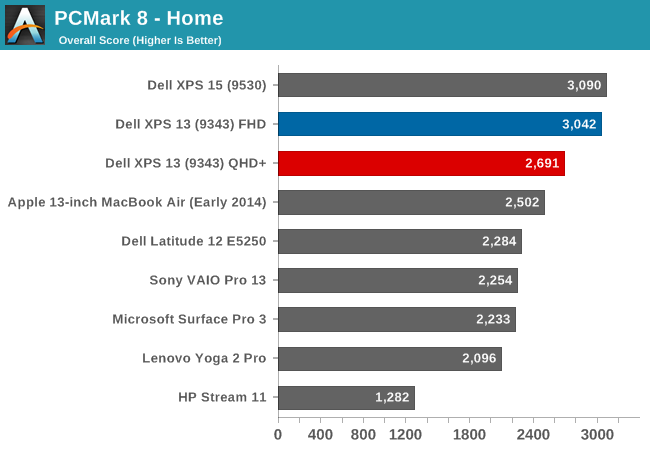
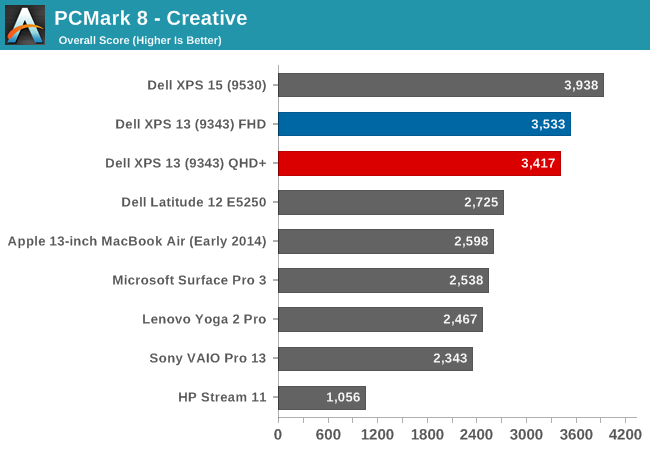
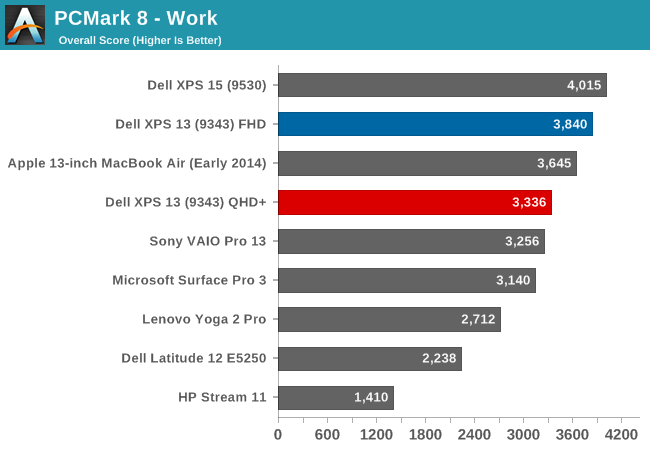
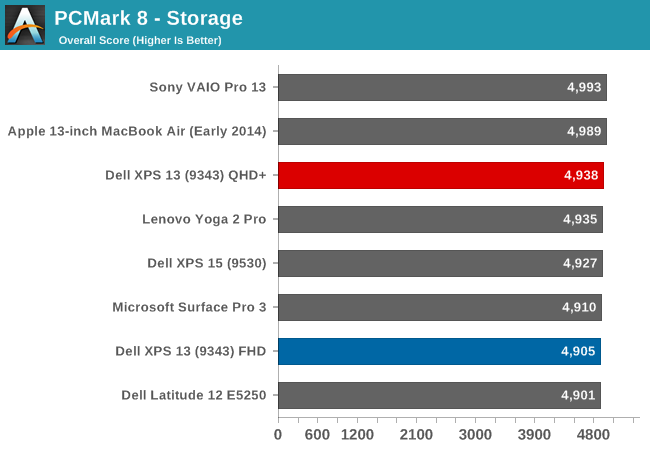
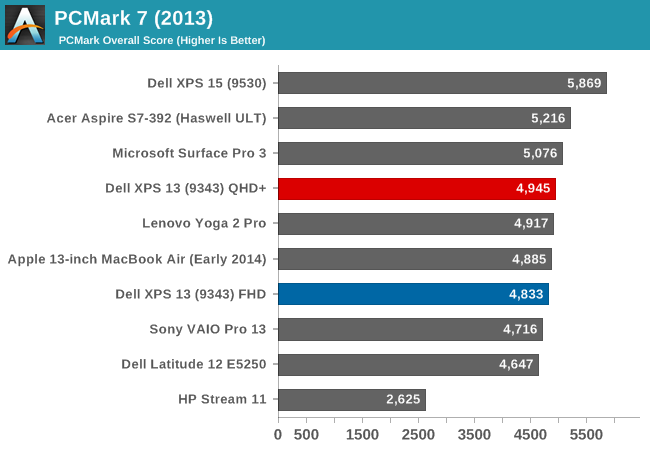
PCMark 8 from Futuremark runs through a variety of tests, and many of the test feature OpenCL support. The Home benchmark runs through what the typical home user would do: web browsing, gaming, and photo editing. Creative is for media and entertainment creation and is more demanding than the Home test. The Work suite tests basic office tasks. The higher resolution model has more work to do on these and scores a bit behind the 1080p model, but overall the new XPS 13 scores quite well on these types of workloads.
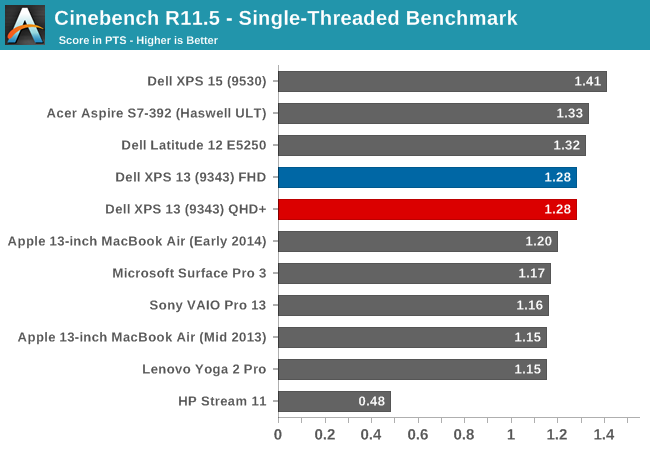

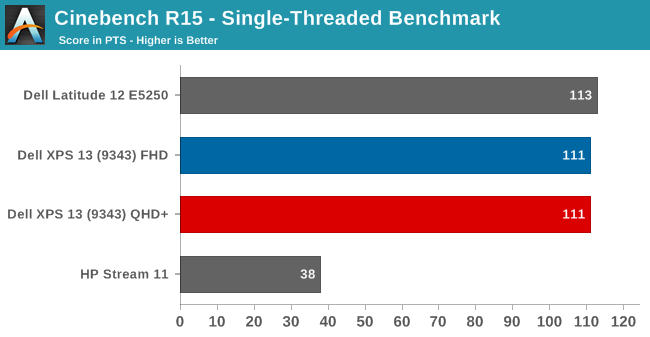
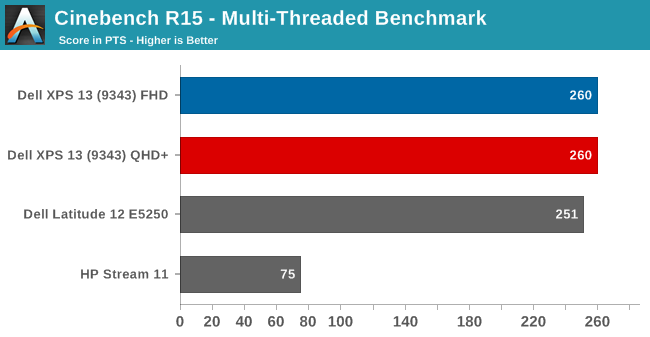
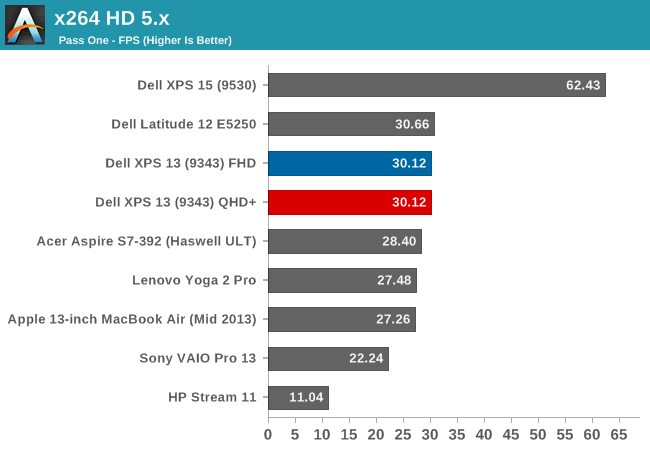
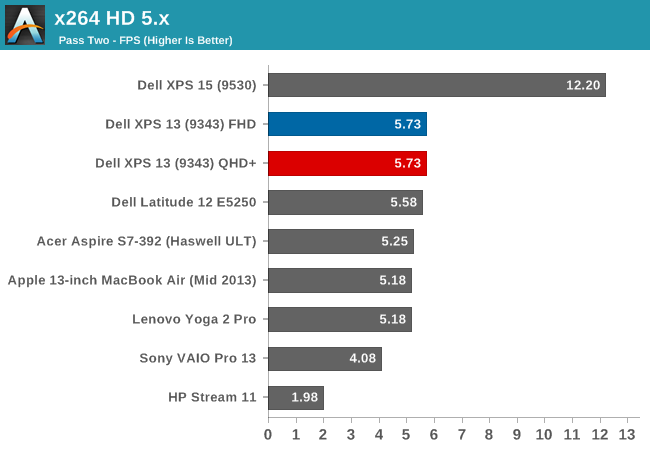
Cinebench tests the CPU's ability to render a scene. Broadwell-U does well here, and though the single core scores show that the i5-5200U is a bit slower than the Acer's i7, and especially the XPS 15 with it's higher TDP part, there is a nice bump up from the i5-4200U in the Lenovo Yoga 2 Pro. Multithreaded is where the new 14nm process can really shine. The lower power usage means that there is more headroom for the CPU to keep the clock speeds higher when all cores are active, and it shows a great result here compared to the Haswell-U series parts. x264 HD also shows favorable results for Broadwell, with the i5-5200U outperforming the old i7-4500U. The Dell XPS 15, with the full quad-core, eight-thread CPU, unsurprisingly outperforms all of the U series CPUs.
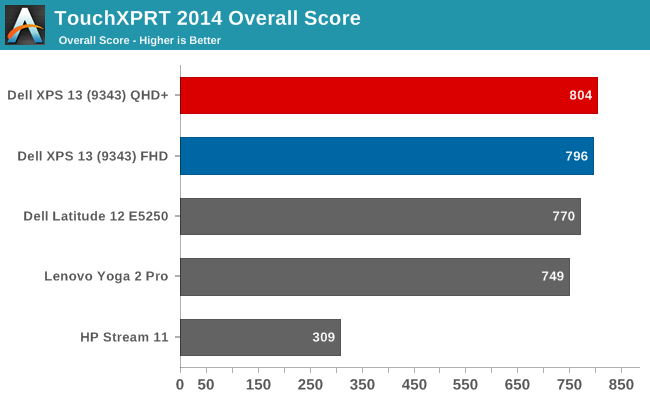
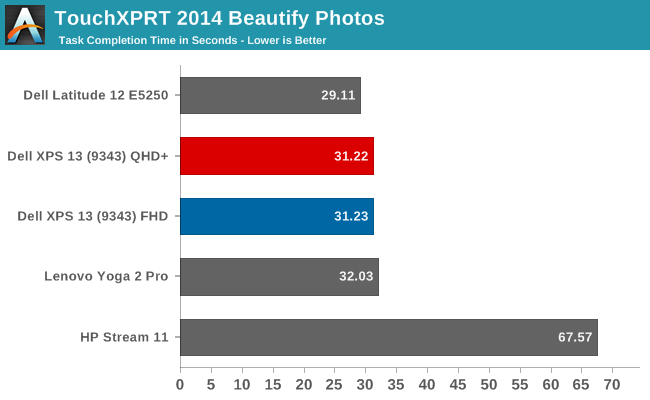
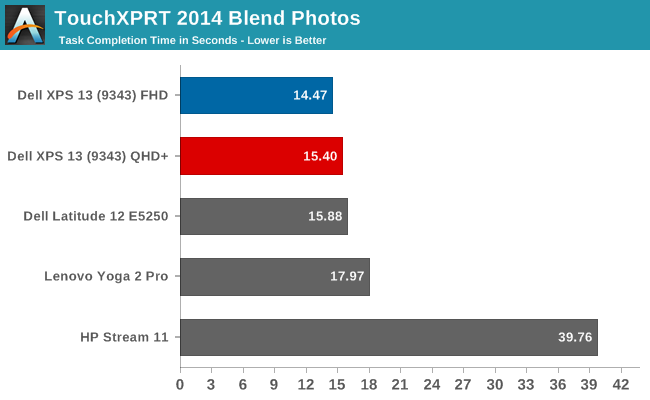
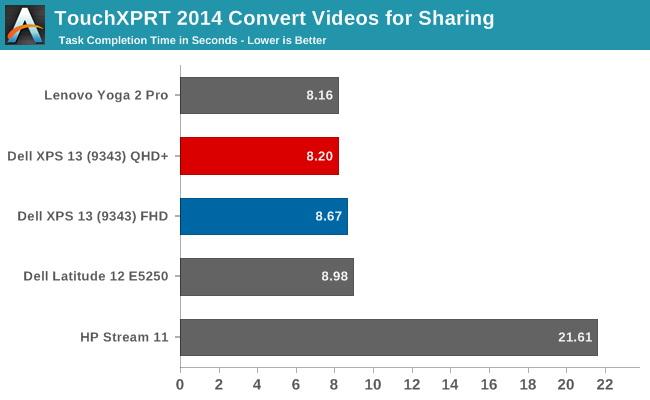
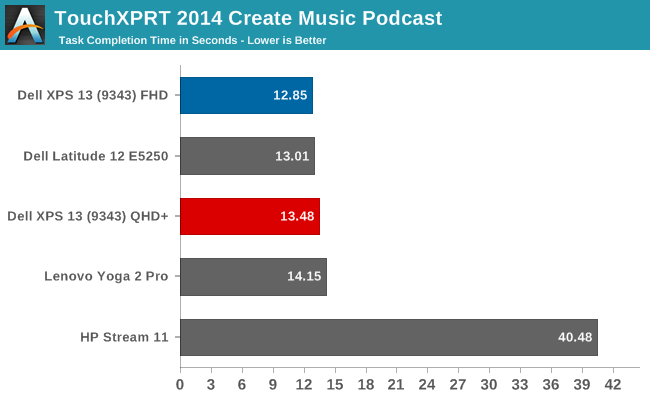

TouchXPRT 2014 is a WinRT app found in the Windows App Store that performs a series of common tasks for a typical home user, and calculates a score based on how quickly the tasks were performed. Here Broadwell seems to perform very similarly to Haswell, with the exception of the video conversion which was quite a bit slower. Update 2015-02-20: Intel has provided us with an updated graphics driver which solves the slow video conversion issue. I have re-run the tests and updated the graphs. If you would like to install this driver from Intel.com, you must first remove the existing one from Programs and Features or you will be blocked from installing, since the version that comes with the device is from Dell.
The Yoga 2 Pro has the Core i5-4200U, and the Dell XPS 13 is the Core i5-5200U, so it makes a good comparison for performance. Overall, the Broadwell based XPS 13 is generally slightly faster than the previous generation processors, but not by much for most single cpu tasks. Multithreaded scenarios show a nice gain in performance with Broadwell just from the ability to keep the clock speeds higher under heavily threaded loads.
As expected, the switch to 14nm did not bring a huge performance change for the CPU, and for that we may have to wait for Skylake, which is the next Tock from Intel (new processor architecture) coming later this year. The Dell XPS 15, with its higher wattage quad-core CPU, shows a clear lead as expected, and the Atom processor in the HP Stream 11 is sorely outclassed.
Interestingly, the FHD model was able to outperform the QHD+ model on a couple of the PCMark 8 tests. I’ve re-ran the benchmarks several times, and these results are consistent. The PCMark tests do include some gaming and other GPU loads which would be slower on the high DPI display.
WiFi
The review units we received both came with the Dell Wireless AC 1560 adapter, which is based on a Broadcom chipset. Originally I had connection issues on 5 GHz with the QHD+ model, but Dell shipped out a driver update which seems to have sorted that, so if you have purchased one of the early model XPS 13s, check Dell’s site for some updates.
Optionally, Dell will outfit the XPS 13 with the Intel Dual Band Wireless-AC 7265 adapter, or the spec sheet also lists the Wireless-N version of this Intel adapter. I have seen and used the AC 7265 on a couple of machines, such as the Dell Latitude 12 E5250, and it performed very well.
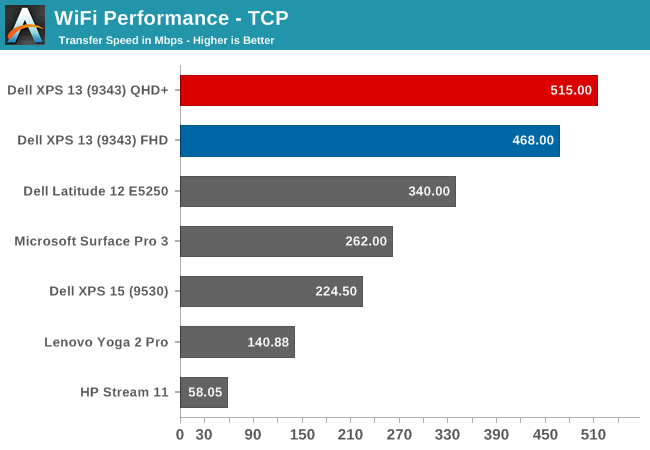
Wireless performance was very good, with the Broadcom chip pulling to the top of the chart. Once the initial connection issues were resolved with the driver update, I had no problems with the wireless connection on the XPS 13.










201 Comments
View All Comments
jospoortvliet - Friday, March 27, 2015 - link
Somebody bothered, years ago: Samsung series 9. Where they beat Dell to small bezels, they also announced the series 9 2015 model in December 2014: 12" screen, under 1 kg (2 lbs), passively cooled core M, high res screen and long battery life. Yeah, that is Apple's new MacBook, just three months earlier.Series 9 had been and continues to be ahead 😃
jospoortvliet - Friday, March 27, 2015 - link
Somebody bothered, years ago: Samsung series 9. Where they beat Dell to small bezels, they also announced the series 9 2015 model in December 2014: 12" screen, under 1 kg (2 lbs), passively cooled core M, high res screen and long battery life. Yeah, that is Apple's new MacBook, just three months earlier.Series 9 had been and continues to be ahead 😃
retrospooty - Thursday, February 19, 2015 - link
Looks like some great specs and a great laptop... Hopefully it doesn't suffer from the odd glitches and high fail rates that some (not all) Dell products suffer from. Time will tell.programcsharp - Thursday, February 19, 2015 - link
I like this, but what I really want is a 15" version with a bit more oomph. The 13" ends up being cute but pricey.Do a 15" QHD+ version with an i7, 512gb ssd and 32 gb RAM and now we're talking.
esterhasz - Thursday, February 19, 2015 - link
Not to forget: all you're saying, and in the footprint of a 13" machine!andrewaggb - Thursday, February 19, 2015 - link
agreed. A 15" (13" frame) machine would be great.jeffkibuule - Thursday, February 19, 2015 - link
Quad core Broadwell chips still haven't shipped, which is why we probably haven't seen a new 15" laptop from any major OEM yet.I'm also not sure we will get 32GB in a mainstream laptop yet, seems 16GB is still the top for the high end. Maybe with DDR4?
UtilityMax - Wednesday, February 25, 2015 - link
The statement that a 15 inch laptop needs a quad-core CPU is a little perplexing. The only quad-core Intel CPUs for laptops are the high wattage versions of the Core i7 CPUs, and they represent a valuable but very small portion of the market. More and more high end laptops ship with the "U" series if Core i7 CPUs, which are dual core, even in machines that are meant to replace quad-core offerings. The value is multiple cores is seriously over-hyped as far as desktops are concerned. Lots of applications are still single threaded, or multithreaded where one core still bottlenecks the main thread. Two fast cores are plenty for most laptop and tablet users, specially if that saves battery life.extide - Thursday, February 19, 2015 - link
Yeah, 8GB is just not going to do it for me these days. 16GB min, and 32GB preferred. Also I would like a 35w quad core, instead of a U-series. However I DO NOT want discrete graphics! It seems like pretty much all laptops with 35/45w quads have discreet graphics as well. I think Clevo makes a model (Haswell) that is like this, though. Although Clevo machines are great in the fact you can customize the crap out of them, their all-plastic build makes them a bit fragile. I have a P150EM (Ivy Bridge) and I am nearly afraid to take it around much, because I don't want it to get damaged, vs my work laptop which is a Latitude E6530 which is a straight up tank, I mean I can/have dropped it, kids walk on top of it, and no damage whatsoever. Any of that crap to my P150EM, and something will break!aryonoco - Thursday, February 19, 2015 - link
I would have bought this laptop (with i5, QHD display and 256GB SSD) in an instant if it had 16GB version.The way I use my computer, I've got a lot of applications and generally over 20 tabs open at any times, sometimes 50-60 when I'm in the middle of research. I just can't live with 8GB.
Pity, cause it's an excellent laptop otherwise. Maybe the Skylake update will bring a 16GB option.